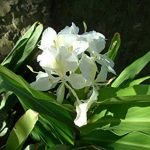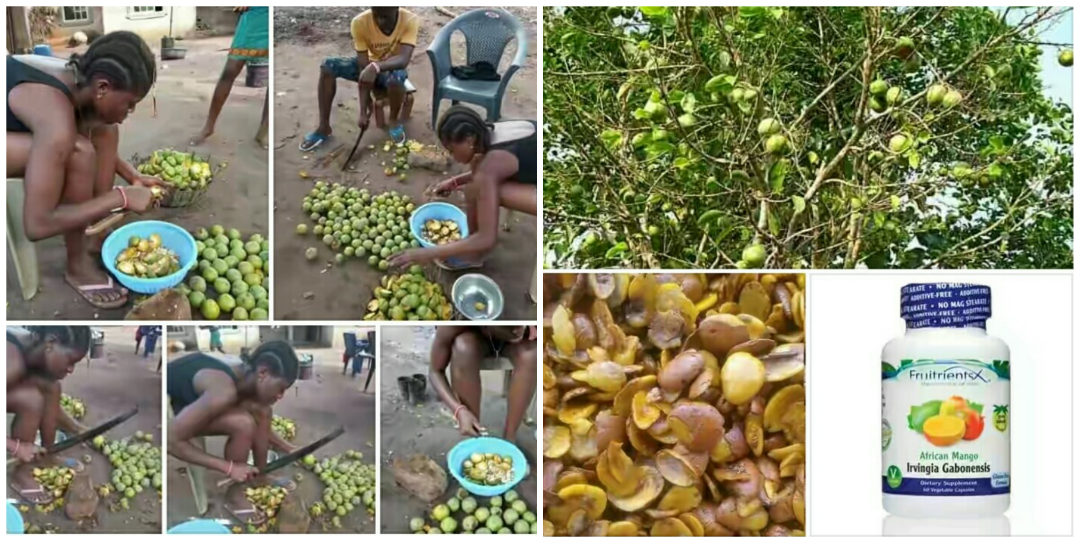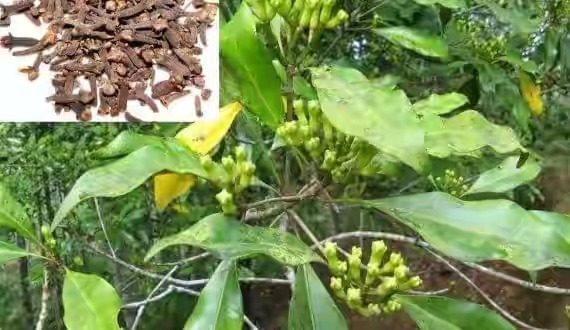Costus afer Ker Gawl. or Ginger lily, Common ginger lily, Spiral ginger, ‘Bush-cane’ (English) or Kaki-zuwa, Kaki-zuwa-Hausa = thou refuses to come to Hausa!, Tumfafiyar kadaa = crocodile’s alotropis (Hausa) or Ókpètè, Ọ́kètè, Ókpòtò, Ókpìtì (Igbo) or Andura (Jukun) or Atare tẹ̀tẹ̀-ẹ̀gú (Yoruba): A plant with many therapeutic values with an unjustified Hausa name.
IDENTIFICATION
Tumfafiyar kadaa is a perennial, rhizomatous herb up to 4 m tall. Leaves arranged spirally, simple and entire; sheath tubular, closed, green with purple blotches; ligule 4-8 mm long, leathery, glabrous; petiole 4-12 mm long; blade elliptical to obovate, 15-35 cm x 3.5-9.5 cm, base rounded to subcordate, apex acuminate, margin sparsely hairy, usually glabrous above, sometimes shortly hairy beneath. The plant while occurring fairly commonly in the wild, particularly in the higher rainfall areas, is often planted in gardens. The significance of the Hausa name ‘Thou refusest to come to Hausa’ is not clear for the plant is common in Hausaland. Tumfafiyar kadaa is commonly used as a medicinal plant throughout tropical Africa.
IMPORTANCE/HEALTH BENEFITS OF GINGER LILY
An infusion of the inflorescence is taken to treat tachycardia (a faster than normal heart rate. A healthy adult heart normally beats 60 to 100 times a minute when a person is at rest. If one has tachycardia (pronounced: tak-ih-KAHR-de-uh), the rate in the upper chambers or lower chambers of the heart, or both, are increased significantly). The same infusion or a rhizome infusion is taken to treat stomach complaints.
The sap is somewhat rubefacient, and on open wounds is burning, yet it is also anodynal and healing. Sap from a fresh plant or a decoction of the dried plant is used in Ivory Coast – Upper Volta in eye-instillation for various eye-affections and for headache, and in frictions for oedemas and fever. Leaf sap is used as eye drops to treat eye troubles and as nose drops to treat headache with vertigo, and in frictions to treat oedema and fever. Leaf sap or a rhizome decoction is taken to treat malaria.

Credit: Amazon
Stem sap is applied to treat urethral discharges, venereal diseases, jaundice and to prevent miscarriage. Stem sap is acid and rubefacient and burns on open wounds, but it is also anodyne and healing, and is applied to different skin ailments.
A stem decoction is widely taken to treat rheumatoid arthritis. An infusion of the dried aerial parts is taken to treat hypertension. The powdered stems are used as an enema to treat worms and haemorrhoids.
The Akye people of Ivory Coast mix the leaves with those of Aframomum sceptrum (Grains of paradise or Guinea grains) and use the expressed sap in nasal instillation for headache with vertigo: the mixed leaves are also applied to the face.
A stem-decoction is widely used for treatment of rheumatism and in Casamance (Senegal) and in Gabon crushed stems rubbed on to wounds immediately after their infliction give good results for cleansing and healing. A stem decoction, the mashed or chewed stem or the pounded fruit, sometimes mixed with sugar cane juice, are taken to treat cough, respiratory problems and a sore throat. The smoke of the dried stem is also inhaled to treat cough. In Sierra Leone the stem is mashed or chewed to relieve cough. The pulped-up stems taken in a little water are strongly diuretic. This is used in Ivory Coast-Upper Volta to relieve urethral discharge.
The Ijo people of Southern Nigeria express the sap which is taken for malaria and to clear urine. The deleafed and debarked stem is used in Nigeria against attacks of nausea and young stems are sucked by the Efik to quench thirst. A cold water extract of the stem is taken to treat small epileptic attacks. Leaf-sap in a root-decoction is drunk in Tanganyika for malaria. The outer layer of the stems is used in Lower Dahomey to weave into small table mats, kola baskets, etc., and the plant is sometimes cultivated for this purpose. The stem has some value as a paper material, and good quality brown and white papers have been produced. Many years ago, children in Southern Nigeria use the stems for cleaning school slates. The sap can be used to coagulate rubber. Nigerian material has been found free of alkaloids.
The root is used in the Benue State, Nigeria for cough, and a decoction of roots and epiphytic orchids has been used as a remedy for sleeping-sickness. In Casamance (Senegal), the roots mashed to a thick paste are applied topically to abscesses and ulcers and they are put into a popular medicine for constipation. In Nigeria, a root-infusion is taken for stomach-ache and is considered to be a stimulant and an aphrodisiac.
In Gabon, the root is boiled to a pap and taken for syphilis and a decoction is taken in Tanganyika for leprosy and gonorrhoea. Rhizome pulp is applied to abscesses and ulcers to mature them, applied to teeth to cure toothache, and mixed with water it is taken to treat diarrhoea and amoebic dysentery. A rhizome decoction or the raw rhizome is taken to treat leprosy and venereal diseases.
In Gabon the stem sap is rubbed on the body to treat colic. In Sierra Leone, the canes are laid under bodies of the dead, and when twins are born they are (canes) laid by an anthill.
In Togo, Costus afer is sometimes cultivated for the stem bark which is used to make table mats and baskets. Experiments in Uganda to use it for making paper were successful.
In Democratic Republic of Congo, the stems are used in house construction. The sap can be used to coagulate latex and is also used in skin nourishing creams. In West Africa, Costus afer is used as a fodder for small ruminants and poultry and the leaves serve as a feed for snails.
In Ghana, the plant has many superstitious uses. It is placed on a cultivated field, or path, or entrance to a house for protection, and planted in sacred groves. It is used in religious ceremonies. Its smell is regarded as inimical to ghosts and evil influences, and it is offered to a spirit occupying a tree.
The stem, seeds and rhizome of Costus afer contain several steroidal sapogenins, of which diosgenin is the most important one. The rhizome yields 0.5% diosgenin. Diosgenin is a very important raw material used as a precursor in the synthesis of a number of steroidal drugs, including corticosteroids, sex hormones, oral contraceptives and anabolic agents.
PROSPECTS: Costus afer is widely used as a medicinal plant in tropical Africa and several uses have been confirmed by pharmacological tests, although no systematic evaluation of the active compounds of the different plant parts has been effected. The diosgenin content needs further study as well, especially because the content is higher than commercially grown diosgenin-producing Costus spp. Costus afer has some value as an ornamental plant.
These are the thoughts of:
Sa’eed Halilu Bawa
Senior Lecturer (Associate Professor) at University of the West Indies, St. Augustine Campus, Trinidad.
Studied Food and Nutrition Sciences, Dietetics at Kaduna Polytechnic, Nigeria; Warsaw University of Life Sciences, Poland.
























